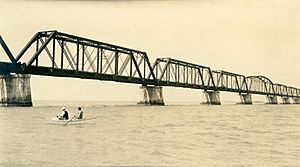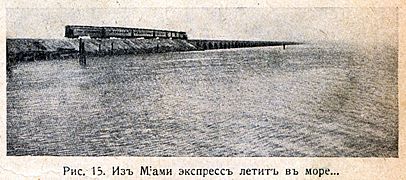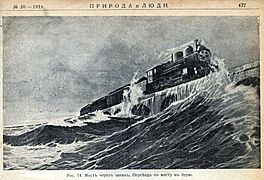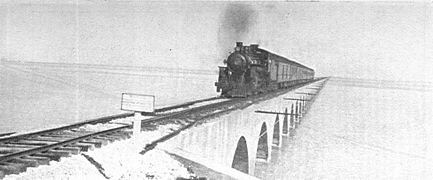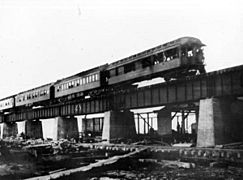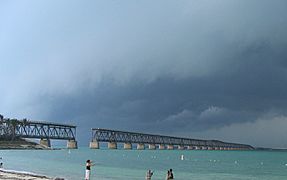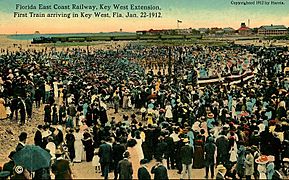Overseas Railroad facts for kids
Quick facts for kids |
|
|
Overseas Highway and Railway Bridges
|
|
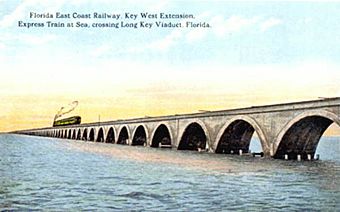
|
|
| Location | Bridges on U.S. 1 between Long and Conch Key, Knight and Little Duck Key, and Bahia Honda and Spanish Key, Florida Keys, Florida |
|---|---|
| Area | 30.2 acres (12.2 ha) |
| Built | 1905 |
| Architect | Florida East Coast Railway; Overseas Highway & Toll Bridge Comm. |
| Architectural style | Arch, Girder & Truss Spans |
| NRHP reference No. | 79000684 |
| Added to NRHP | August 13, 1979 |
The Overseas Railroad was a special train line that stretched all the way to Key West, a city located about 128 miles (206 km) beyond the tip of the Florida peninsula. It was an extension of the Florida East Coast Railway. People also called it the "Overseas Extension" or "Flagler's Folly." Construction started in 1905, and trains ran on it from 1912 until 1935. A powerful storm, the Labor Day Hurricane, damaged it so badly that it could no longer operate.
Contents
Henry Flagler: Building Florida's East Coast
Henry Flagler (1830–1913) was a very rich businessman from the United States. He was one of the founders of Standard Oil, a huge company. Flagler became interested in Florida in the late 1870s because he was looking for a warmer place for his first wife, who was sick.
When he returned to Florida in 1881, he started building fancy hotels and railroad lines along the state's east coast. He began in St. Augustine and gradually moved south. Flagler helped develop popular places like Ormond Beach, Daytona Beach, and Palm Beach. He is even known as the "Father of Miami" because of his work there.
Flagler's railroad network grew into the Florida East Coast Railway (FEC). By 1904, his trains had reached Homestead, which is just south of Miami.
The Amazing Key West Extension
In 1905, the United States announced plans to build the Panama Canal. Henry Flagler then became very keen on connecting Key West to the mainland. Key West was the closest deep-water port in the U.S. to the Canal. This meant it could become a major hub for trade with Cuba, Latin America, and even the West Coast of the U.S. once the Canal opened.
Building the Overseas Railroad was a huge challenge. Many people called it "Flagler's Folly" because it seemed impossible. It needed lots of new engineering ideas, a massive amount of workers, and a lot of money. Once Flagler decided to go ahead, he sent his engineer, William J. Krome, to find the best path for the railroad.
They first thought about extending the line from Homestead through the Everglades to Cape Sable. From there, it would cross 25 miles (40 km) of open water to Big Pine Key and then on to Key West. However, they soon realized it was much easier to build the railroad south to Key Largo and follow the chain of islands known as the Florida Keys. Krome then found a route through Jewfish Creek, which became the chosen path.
At one point, about four thousand men were working on the project. During the seven years of construction, three powerful hurricanes hit the area. These storms in 1906, 1909, and 1910 threatened to stop the project completely. Despite these challenges, the project cost more than $50 million.
Finally, the last part of the railroad to Trumbo Point in Key West was finished in 1912. Henry Flagler, very proud, rode the first train into Key West on his private railcar. This moment marked the completion of the incredible oversea connection to Key West. It also linked the entire east coast of Florida by railway. Many people called it the "Eighth Wonder of the World" because it was such an amazing feat of engineering.
The End of the Railroad
A large part of the Overseas Railroad in the Middle Keys was badly damaged and partly destroyed by the Labor Day Hurricane of 1935. This was a Category 5 hurricane, the strongest kind, and is often called "The Storm of the Century." The storm caused the deaths of over 400 people and completely ruined Long Key and nearby areas.
The Florida East Coast Railway's fishing camp on Long Key was destroyed. Even an FEC rescue train, except for its engine, was flipped over by the huge storm surge at Islamorada. More than 40 miles (64 km) of track were washed away by the hurricane. Two miles of this track even ended up on the mainland at Cape Sable.
The Florida East Coast Railway was already in financial trouble and couldn't afford to rebuild the destroyed sections. So, the railroad's path and the bridges that were still standing were sold to the State of Florida. The state then built the Overseas Highway to Key West, using many parts of the old railway. Many of the original bridges were replaced in the 1980s.
Today, the Overseas Highway (U.S. 1) still connects Key West to the mainland. Many of the old concrete bridges from the Overseas Railroad are now used as fishing piers and walking paths. These paths are part of the Florida Keys Overseas Heritage Trail.
The Overseas Highway and Railway Bridges were added to the National Register of Historic Places in 1979.
Gallery
-
Henry Flagler's train with his private car "Rambler" returning from Key West, Florida on the Overseas Railroad
-
Overseas Railroad bridge west of Bahia Honda Key, 2006. The bridge has been severed to prevent pedestrian access.
Images for kids




